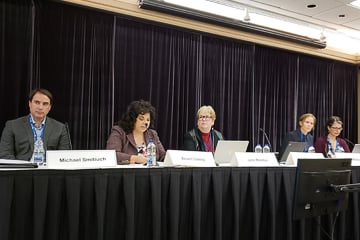When nursing home negligence cases enter litigation, opting for a jury trial, while surreptitiously building the case, will likely increase the elderly plaintiff’s odds of receiving a higher amount of damages, said a panel of lawyers at the Personal Injury and Elder Law program at the Ontario Bar Association’s Institute on Feb. 6.

When nursing home negligence cases enter litigation, opting for a jury trial will likely increase the elderly plaintiff’s odds of receiving a higher amount of damages, said a panel of lawyers at the Personal Injury and Elder Law program at the Ontario Bar Association’s Institute on Feb. 6.
Judges historically have preconceived notions that nursing home cases are worth extremely small amounts of damages and lawyers arguing for the plaintiff will face an uphill battle in shifting the judge’s already-formed view that these cases attract little in damages, without a jury, said panelist Amani Oakley, a senior partner at Oakley & Oakley PC, during the session in Toronto.
“Juries have grown up on a steady diet of American television and they see these giant numbers. [The defendant’s legal representation has] got to talk them down from that,” said Oakley. “When [clients] call you and say, ‘Mom passed away in a nursing home,’ they think they’re getting millions, so understand that juries have that in their head.”
Panelist Mike Smitiuch, founder and lawyer at Smitiuch Injury Law, provided an example where in his practice, having a jury trial was the best way to increase awards. He said that, during a chronic pain case, the jury came back from deliberations and awarded more than $600,000 in damages. The judge had to knock it down to the cap. This safeguarded the client from being, essentially, low-balled.
In Canada, there isn’t plentiful case law for nursing home negligence cases. There have been some notable cases, including Coulson v. Sunrise North Senior Living Ltd., Singleton v. Leisureworld Inc., Stewart v. Extendicare Ltd. and Wells v. Paramsothy, so the best way to advance these types of cases is to go to trial, the panel said.
Smitiuch said arguing Ontario’s “Golden Years Doctrine” is important in protecting elderly plaintiffs when being awarded damages.
In the past, defendants have argued that non-pecuniary damages, which aren’t quantified and include compensation for pain and suffering, should be lower for the elderly because they have less time to suffer — they have already lived most of their lives and are closer to death than younger plaintiffs. However, the Golden Years Doctrine argues that the elderly should actually receive higher damages because the elderly suffer a greater deal due to age and would be impacted more severely from an injury than their stronger, younger counterpart.
“This is ageism. There’s no question,” said Oakley. “If you’re older than 50 or 60 and you have anything wrong with you at all in your history, there is a knee-jerk movement to say, ‘You’re going to die anyway,’ or, ‘ We don’t need to look at this very closely.’”
When arguing these sorts of cases, as a strategy, focus on the injury first rather than the age, she said. She added that it’s important to build up the case and the suggested damages surreptitiously, bit by bit.
When remodelling the kitchen, bit by bit, the homeowner purchases new cabinets, new backsplash, new countertops, a new sink, etc., which all appear to be relatively smaller costs at first — until they add up to a hefty bill in the end. Seeing the final numbers is a lot more shocking to the homeowner than seeing the smaller costs individually. This is the example Oakley provided as comparable to the approach she suggested using in court to maximize the damages for the client and their family.
With the large ageing demographic of baby boomers, many are being placed in nursing homes, and many face the neglect, physical and mental abuse and injury that’s being argued in courts. Without many legal regulations governing these homes, what could prevent these instances from occurring in the first place? How could this area of law be built up?
Oakley said media coverage is key because the media shines a spotlight on these instances, so people will “start sitting up and take notice.” Awareness is important.
Smitiuch said taking the way to advance the damages and these types of cases is to go to trial, letting the awards escalate.
“The legal system has let down elderly people,” said Oakley. “I’m hoping that things will shift in the legal sphere.”










